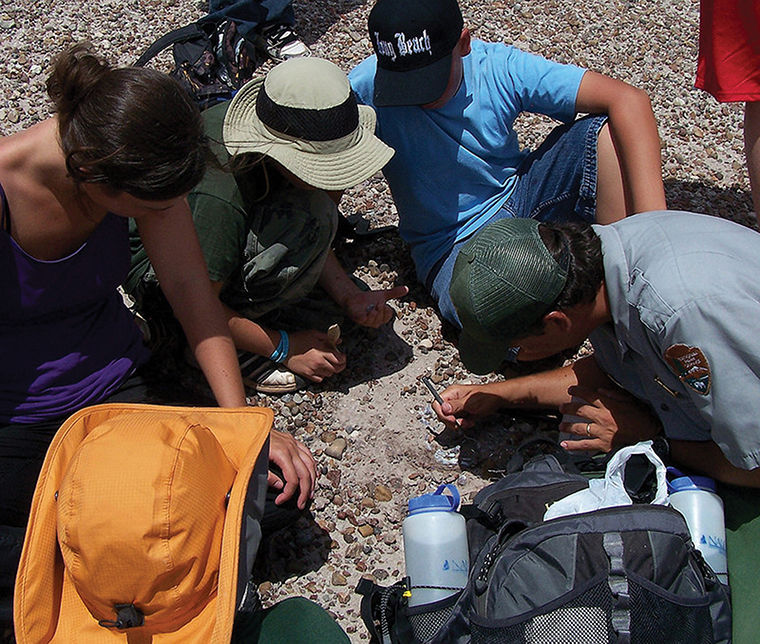Honors program digs up opportunity
Honors students will spend two weeks in Petrified Forest National Park collecting fossils, data and field experience.
February 16, 2015
Seven Columbia students will have the opportunity to spend their summer break collecting fossils and camping under the stars at Petrified Forest National Park in Northeastern Arizona.
The Honors Program announced its first off-campus learning opportunity, “Paleontology Field Observation & Methods: Petrified Forest National Park,” a course in the Science & Mathematics Department.
An application-based opportunity, the selected students will spend five weeks immersed in paleontological studies with an emphasis on gaining field experience.
The class is open to students from the Honors Program as well as those who have an average GPA of 3.5 or higher. Students who are interested in applying must have fulfilled the prerequisite of an Earth Science course, according to Robin Whatley, associate professor of paleontology in the Science & Mathematics Department.
“It’s just exciting that we’re creating an opportunity for students to go into the field with an expert and get hands-on experience in something that you don’t even think of as a typical Columbia experience,” said Andrew Whatley, assistant dean of the School of Liberal Arts & Sciences and associate director of the Honors Program.
Robin Whatley, who teaches classes about vertebrate paleontology and dinosaur evolution, will be accompanying the students. Although students have the opportunity to be introduced to paleontological methods in classes such as Vertebrate Paleontology, she said it is not the same as being able to experience it firsthand.
“There’s nothing like the joys of field work and really understanding what you’ve learned in the classroom by going out into the actual place where fossils are discovered,” Robin Whatley said.
After spending a week of preparing on campus, the class will set up camp in Petrified Forest. Students will also spend time at a quarry in New Mexico.
“The exciting thing about this is that I now know exactly where we’re going in the park,” said Robin Whatley, who has been doing research in the 85,542 square-foot park for the past seven years. “It’s an expansion area that’s just been added to the national park, and nobody’s looked for fossils in one of the areas that we’re going to.”
Students will be looking at fossils that date back to around 220 million years ago, or the late Triassic Period, Robin Whatley said. Petrified Forest National Park has one of the most complete Late Triassic fossil records in the world, she said.
“This period is special because it has early mammals, early dinosaurs, some of the earliest crocodiles and crocodile-like animals,” she said. “Some of the earliest pterosaurs are from this period.”
Guided by Robin Whatley and paleontologists at the national park, students will have the opportunity to search for, collect, screen wash and identify fossils. The majority of their work will be focused on learning how to keep a field notebook.
Pleased with the opportunities that the honors program has provided her, Sarah Matthews, a junior business & entrepreneurship major, said the class is something she is interested in applying for.
“I’ve always really been interested [in] some sort of archaeology or paleontology program,” Matthews said. “I think I would have definitely studied that if I hadn’t come to Columbia. I think this is another way to kind of explore that option.”
Although the course is affiliated with the Science & Mathematics Department, students from all disciplines are encouraged to apply.
“Students can bring their own expertise to this, whether it’s performance or whether it’s film, whether it’s writing,” Andrew Whatley said. “They can come to this experience with their talents, and it will have a life even beyond the class.”
After returning to campus, students will present their experience and findings as a final project through a medium of their choice. Students will then work with Robert Blandford, associate professor in the Business & Entrepreneurship Department, to display the projects next fall in the Hokin Gallery space as part of an exhibit that Robin Whatley’s current vertebrate paleontology class is working on.
According to Andrew Whatley, the course could help students training to be part of the museum world learn how to contextualize scientific information for general audiences.
“I always try to work a public education component into my classes,” said Robin Whatley. “This one is really observing natural history, but also really experiencing science and telling people what that is.”
Information sessions for interested students will be held on Feb. 16 at 3 p.m. and Feb. 18 at 2 p.m. in the Quincy Wong Center in the 623 S. Wabash Ave. Building.








